This post is part of a three-part series on middle managers and Cloud Native transformation. Here are parts one and two.
In the second part of this series we looked at how mid-level managers may not wholly function as a force for good within your organisation, and the ways that this ‘frozen middle’ may actually be impeding progress. The power they hold over an initiative’s success often goes unrecognised, but it does exist and can be used to accelerate forward motion...or block it from happening.
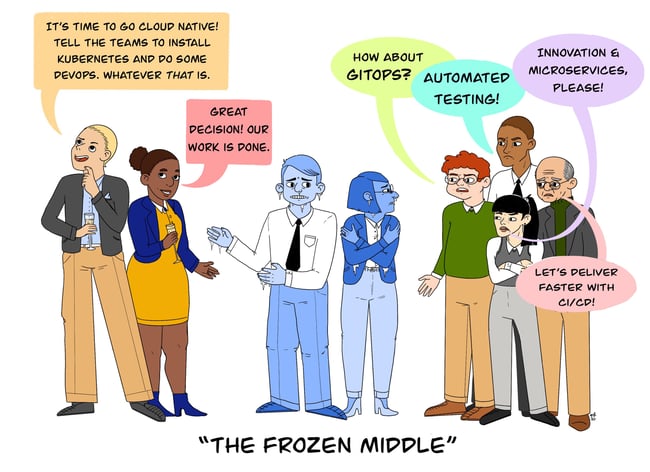
Now let’s look at what you can do about it.
Patterns for Success
Fortunately, it’s easy enough to switch the poles from negative to positive. Once you’ve appreciated the power that resides in this central tier of management, you can apply a bit of foresight, empathy and imagination to leverage it—and move your business much more quickly as a result.
As an additional help, you can also apply patterns. A quick definition of a pattern is a modular solution to a frequently recurring problem or challenge; patterns describe practical actions to address this particular (and common) situation. They are modular because they can fit together with other, related, patterns to create a complete solution to a complex issue, such as designing a Cloud Native transformation. (For more about this, check out the free download excerpt from Container Solutions’ new book from O’Reilly, Cloud Native Transformation: Practical Patterns for Innovation).
Helpfully, there are patterns that describe different ways to engage and motivate, i.e. unfreeze, your middle. Summary versions of relevant patterns are paired below with suggested tactics and techniques. Find the full versions, with practical steps and actions included, on the Cloud Native patterns repository website, CNPatterns.org.
Clarify the narrative
The first and simplest thing you can do is clarify the narrative for your middle management. Once you’re set on a path of change, you need to persuade them you’re serious about making it happen. All too often, messaging around change gets lost in the maelstrom of all the other routine messaging that middle managers constantly have to process. In addition, the message itself can be so verbose that the core of the story can get lost in the noise.
When telling the story to your middle management you need to make sure you speak to their concerns, highlighting:
- Why the change is necessary. What threats or opportunities does it tackle?
- What’s in it for them?
- What are you doing to help them?
- What have you learned so far in the program?
Finally, make sure the core message is repeated consistently over and over again so that focus is not lost.
To address all these points—and make sure the message is getting across—you can apply the Internal Evangelism pattern:
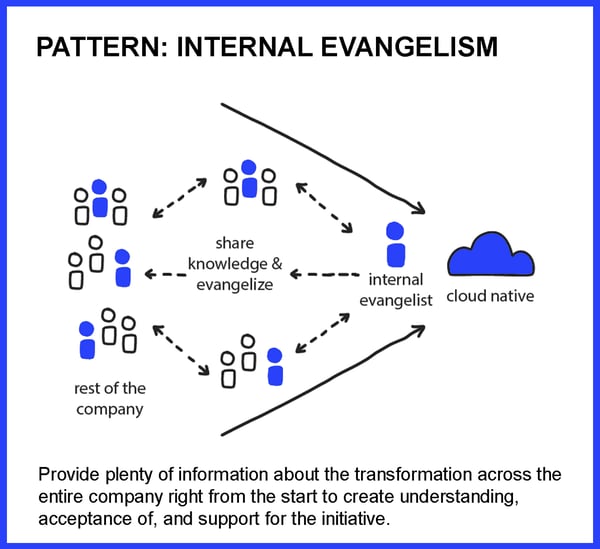
Grasp the emotional nettle
You may have noticed that the points you are advised to address above are a mixture of emotional (‘What’s in it for them?’) and logical (‘Why this change is necessary’). The neuroscientist Donald Calne has argued that ‘The essential difference between emotion and reason is that emotion leads to action while reason leads to conclusions.’ In other words, if you want people to take action, you need to speak to their basic emotional needs.
Henry V took his soldiers into battle with a cry of ‘Once more unto the breach, dear friends, once more!’ rather than a PowerPoint presentation, and you need to take a similar approach.
Case Study No. 3: ‘Get Your Tin Hats On!’
Rather than giving his company a dry analysis of their aggressive marketing strategy, the CEO of a major retail company used a company address to deliver the message: 'Get your tin hats on, people: we’re going to war'. The effect on the staff was electric and they talked about this direction for months afterwards, outperforming their peers for years afterwards.
By engaging with the organisation’s emotions rather using reason and logic, this senior leader provoked action rather than simple agreement with his view. He also gave the organisation a vivid and immediately comprehensible wider view of the company’s approach.
We’re not suggesting you quote Shakespeare to your teams (although there are worse ideas). What we are suggesting is for you to apply the Psychological Safety pattern, making sure that:
- Upper management has genuinely listened to—and, importantly, engaged with and responded to—middle management’s concerns about the change plan
- Middle-management’s fears are safely disclosed to the leadership and heard without judgment
- Upper management has a plan for providing the appropriate support and backup when any challenges arise during the initiative that require adjudication
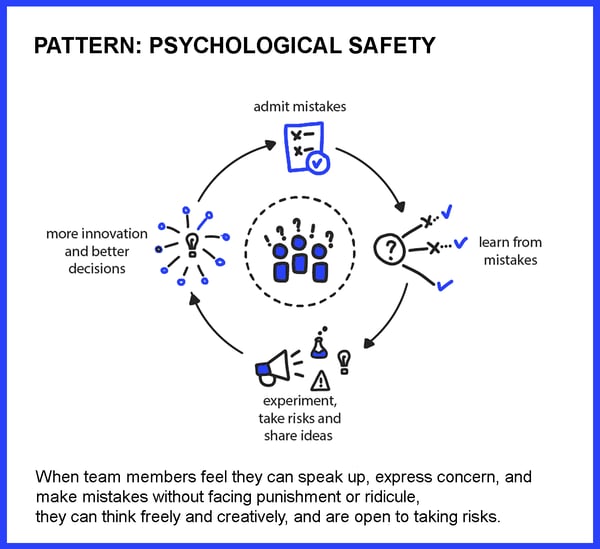
If you get these areas of psychological safety in place then you are far more likely to get an engaged and motivated middle management tier working on your behalf. Or, as Peter Drucker put it, 'Culture eats strategy for breakfast'.
Carrot and stick
With an atmosphere of cultural safety in place, you can now apply more traditional carrot-and-stick methods to promote behaviours that are in line with the direction you want to go in. On the carrot side, you can consider:
Incentivising the ‘right’ behaviours. Meaningful rewards for desirable actions and behaviours will encourage others to follow suit. It will also help demonstrate that the leadership is serious about change.
Providing training and support. Have you provided resources to support your middle management in the transition? Have you paid for certifications, relevant training, books? Doing this provides another strong signal of intent. The pragmatic road to implementing this can be found in the Ongoing Education pattern.
Promoting from within. A common pattern for encouraging change is to hire an outside leader to come in and champion the change internally. This can be surprisingly counterproductive.
First, the ‘outsider’ has a particularly hard time persuading insiders of the need to change. They can become an ‘other’ onto which is projected all the fears and reservations people have about changing. Alternatively, people simply abdicate all responsibility for the change to these ‘outsiders’: You were brought in to make this happen, not me. Another counter-productive outcome happens when external consultants immediately set themselves up as an alternative power base, reducing upper- and middle- management alignment and causing further strife.
The solution? Support and promote an internal ‘champion’ of the change, ideally one with some credibility already within the organisation. The pattern to do this is Transformation Champion:
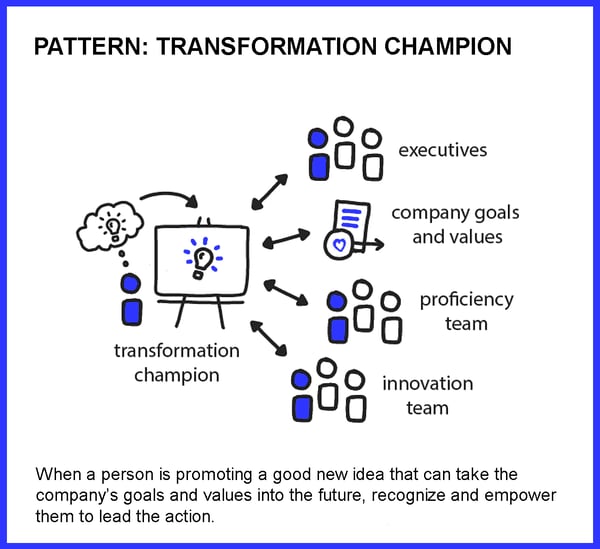
Don’t create this champion. Instead, discover the one who is already there. Empower this person (or group—sometimes a particular team may have been catalyzing things) to lead the initiative, and clearly publicize their role as authorized Transformation Champion.
Support the ‘dirty work’ of change. A common complaint about upper management is that, once the strategy has been announced, they seem to disappear—their involvement and support during the implementation is not felt by the rest of the organisation. When making change, there is often a significant amount of ‘dirty work’ involved around revising old processes, standards, and practices that were associated with previous paradigms. This unglamorous but necessary work often stalls as decisions are deferred due to a general unwillingness to countenance the risks involved.
At these points it is absolutely critical that a direction is set by those with the power to set it. We have the Executive Commitment and Vision First patterns to show us how to do just this. Applying these patterns form the essential first steps in any change action.
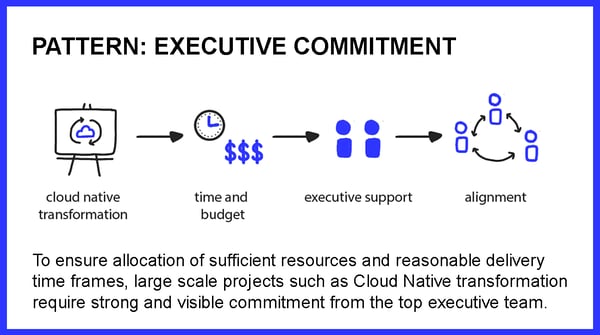
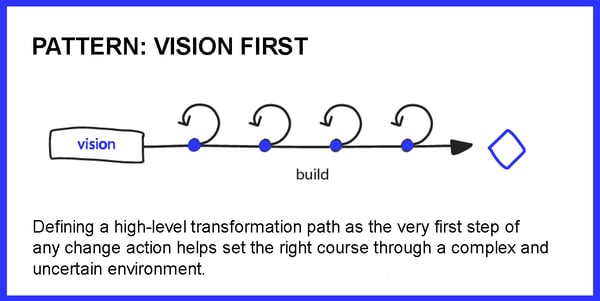
Case Study No. 4: Moving Money In The Cloud
I once worked for a major financial institution that wanted to move workloads to the cloud in order to enact a strategy of ‘getting rid of data centers’. Despite the best of intentions, the project floundered as middle-management governance around delivery refused to move or adapt its base assumptions to the demands of the new technology.
Security and audit requirements written for a world of physical machines in data centres were blindly followed in the transformation, making a nonsense of the transformation effort and repeating the same paradigmatic problems of IT in the new cloud context. Senior leadership refused to arbitrate these conflicts, resulting in the project’s gradual drift towards irrelevance as it failed to deliver the hoped-for benefits.
If senior leadership do not give co-ordinated and clear direction in accordance with the stated strategy, backed up with action when push comes to shove, then the danger is that parts of the organisation just continue to operate in a ‘business as usual mode’.
On the ‘stick’ side, several options are available to you. One tactic is simple but extreme: you can take the approach Jeff Bezos once took at Amazon when mandating a change around 2002, announcing, “Anyone that doesn’t do this will be fired.” Since not all cultures will tolerate this kind of message, it may be better to use the other tools at your disposal to disincentivise non-compliant behaviour. Options include withholding pay rises, canceling bonuses, or simply not advancing anyone who isn’t on board.
Once again, it’s your job as upper management to send the message that the organisation is serious about the changes proposed—and willing to back it through allocation of resources, whether offered as carrot or stick
The Final Conclusion
If you are going to get your frozen middle to work for you, then you need to first respect their power. Middle management is easy to take for granted, and easy to blame when things don’t go the way you’d like them to. Their collective knowledge of the business, culture, informal networks, and processes can often exceed that of senior leadership.
Once you’ve understood their power, you can bring them with you by working on their emotional needs through the transition. You can put this into practice by applying patterns for strategy and organisation/culture. If done in the right way, you can turn the frozen middle from one of your biggest transformation challenges into one of your biggest assets.
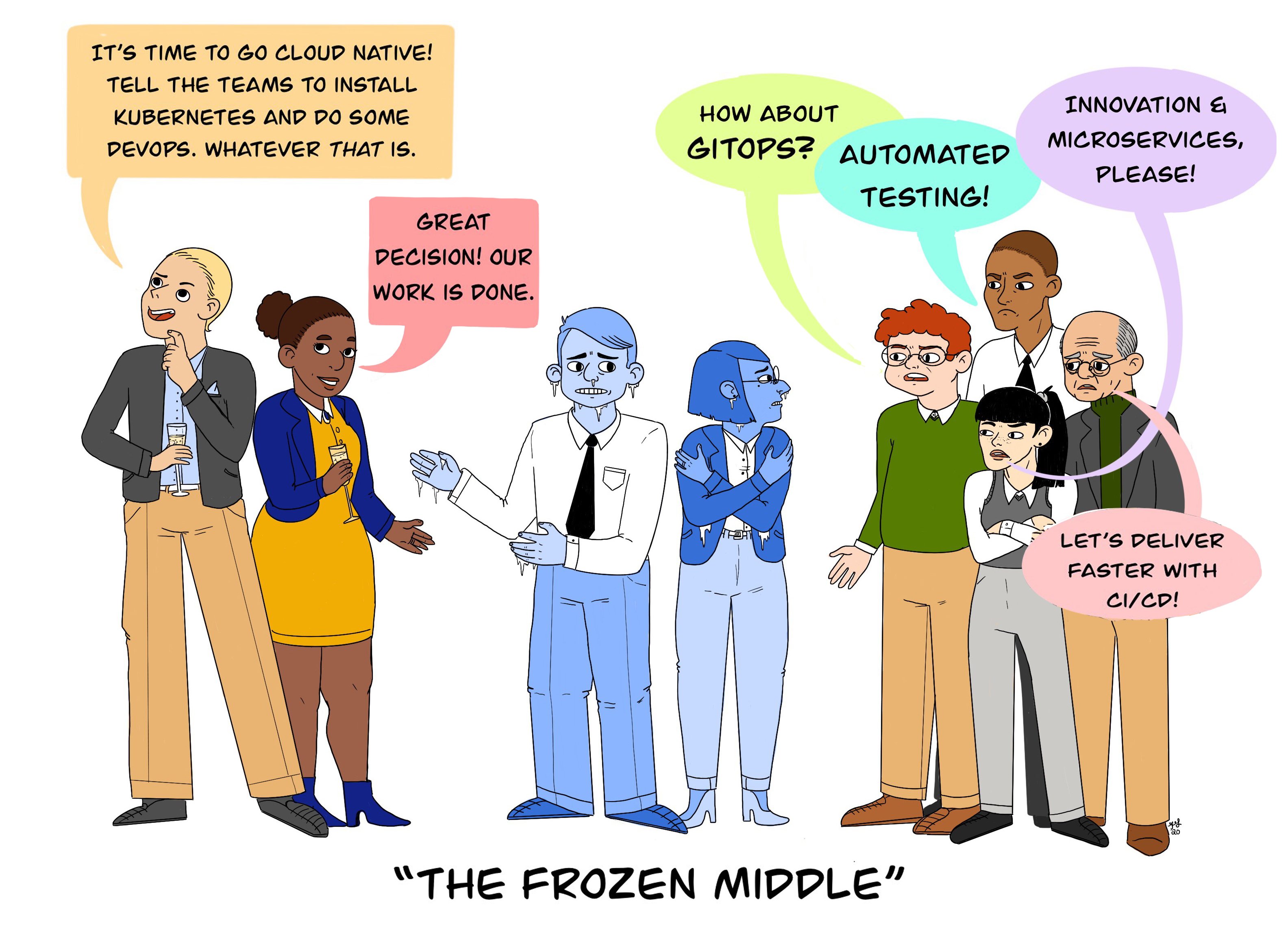


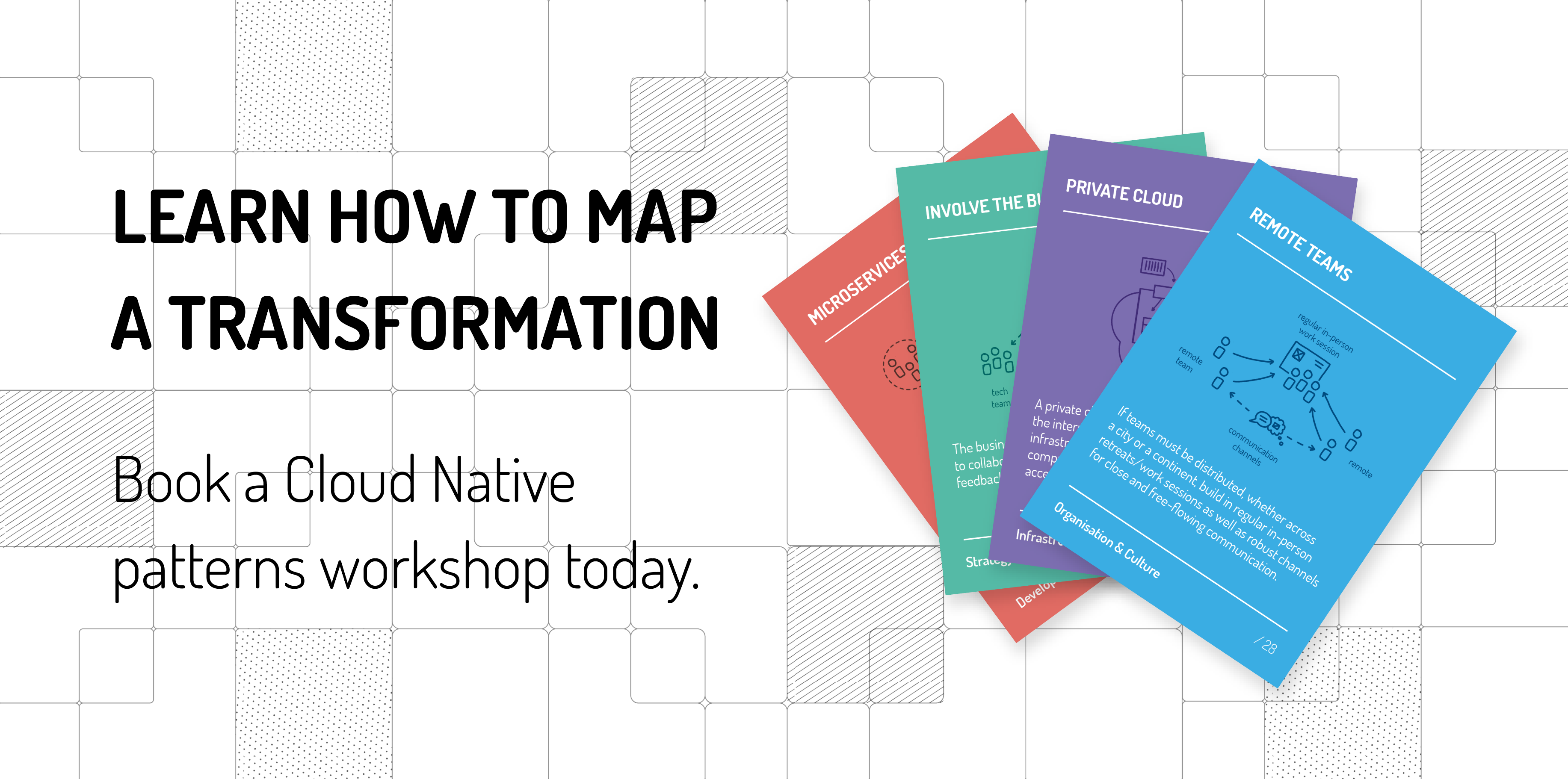
 Previous article
Previous article
